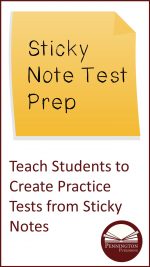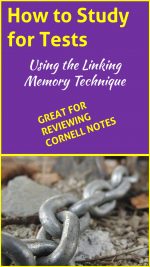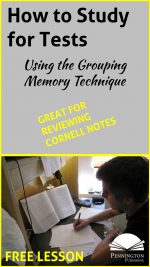How to Study in Advance for Tests
Good students spread out their test study over time and don’t wait until the night before the test to cram. Learning to work “smarter, not harder” will actually save study time, not increase study time. The smarter approach is to study for tests a bit every day after school. Here’s how to effectively study in advance for tests.
Review and Respond to Notes and Assignments
Every day after school at the beginning of your study time, complete a short review of any notes, worksheets, readings, and assignments that you worked on or covered in class that day. This review interrupts the “forgetting cycle” and will help you prepare in advance for tests. Students retain up to 70% of new information if that information is impressed into the long-term memory within the next 24 hours. The level of retention drops to only 10% after one week. So, plan your study schedule to have a study review time soon after school every day.
Use small sticky notes to record possible test questions and memory tricks for the most important content learned that day. Place the sticky notes in the margins of your materials that you review to maintain the context for test study the night before an exam.
Ask the Right Questions
Active participation in class is important test study. Students, who contribute to class discussions, avoid passive learning, and pay good attention do better on tests. Asking questions in advance about upcoming tests will focus test study.
“But, what kind of questions should I ask?” Ask what kind of test you will be taking and adjust your study to that kind of test. After all, good test study should include not only study of what will be on the test, but also on how you will be tested. Will the objective section be multiple choice? Will there be an essay? Ask not only what will be on the test, but also ask what won’t be on the test. Teachers rarely include everything on tests that has been covered in class.
Create a Practice Test
Using your sticky notes, make a practice test that covers the test content in the format that you will be tested. Take the time to brainstorm any possible essay questions and pre-write possible main points and supporting details. Create this practice test days before the test itself. Take the test and review any relative weaknesses after taking this test.
Get More Brainpower
Gather a group of students from the same class to study. Pre-arrange the ground rules for the study session. Set a start and ending time and assign tasks, such as “You bring all the lecture notes; You bring all of the readings; You bring the sticky notes; You bring the chocolate chip cookies.” Assign group members a part of a practice test to develop and share at the study session, including essay pre-writes. More brainpower makes test study fun and increases your likelihood for test success.
Check out these five FREE test prep resources from the author’s Essential Study Skills curriculum:
Get the Test Prep Skills FREE Resource:
![]()
The author’s Essential Study Skills is the study skill curriculum that teaches what students need to know to succeed and thrive in school. Often, the reason why students fail to achieve their academic potential is not because of laziness or lack of effort, but because they have never learned the basic study skills necessary for success. The 56 lessonsin Essential Study Skills will teach your students to “work smarter, not harder.” Students who master these skills will spend less time, and accomplish more during homework and study time. Their test study will be more productive and they will get better grades. Reading comprehension and vocabulary will improve. Their writing will make more sense and essays will be easier to plan and complete. They will memorize better and forget less. Their schoolwork will seem easier and will be much more enjoyable. Lastly, students will feel better about themselves as learners and will be more motivated to succeed. em>Essential Study Skills is the ideal curriculum for study skill, life skill, Advocacy/Advisory, Opportunity Program classes. The easy-to-follow lesson format of 1. Personal Assessment 2. Study Skill Tips and 3. Reflection is ideal for self-guided learning and practice. Contact the publisher for affordable site licenses.








